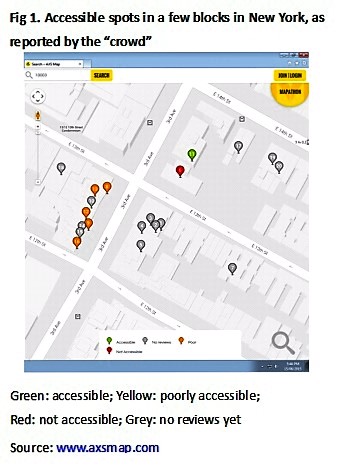How can digital societies contribute to achieving the SDGs for persons with disabilities?
Side Event during the CoSP to CRPD
15 June 2016, 8-9:30am, UNHQ Conference Room 11
Organized by:
Institute on Disability and Public Policy (American University)
AXSMap
WHO
The Nippon Foundation
Data-Pop Alliance
Disabled Persons International
International Disability Alliance
Background
Digitization - the mass adoption of connected digital technologies and applications by society - can play a major role in leaving no one behind. People with cell phones in remote villages with no telephone wires can now call each other and others beyond their villages, respond to SMS surveys and get alerts from services they signed up for. For people with disabilities, digital technologies can improve their participation. People with poor or no vision can find each other in public spaces with the help of cell phones and they can access information online with text to speech applications. People with hearing difficulties can send text messages, like SMS or Messenger, to contact each other. Persons using wheelchairs can find out online which transport stations are accessible.
But there is another opportunity of digitization for disability and development which remains untapped: the capacity to generate evidence to empower people with disabilities. What if people with disabilities could report in an application in their mobile phone whenever they find a school or hospital which is not accessible? These crowd-sourced data could be used to identify spaces where accessibility needs to be improved, to show the extent of accessibility (or the lack of it) in a village, city or country; and ultimately to create a basis of evidence to guide policies and programmes on accessibility of schools or hospitals. Applications already exist for reporting accessible, poorly accessible and non-accessible places for persons with disabilities worldwide (see Figure 1). Similar applications could be created to focus on schools, transport, and public/green spaces to assist the review and follow up of SDG targets 4.a (disability sensitive education facilities), 11.2 (accessible transport for persons with disabilities) and 11.7 (accessible green and public spaced for persons with disabilities). The same could be done for accessible working places.

An alternative source of information to gauge access to the internet and to mobile devices, is the number of downloads of applications commonly used by persons with disabilities. For example, the app BrailleBack, released in 2013, has been downloaded 10,000-50,000 times. But this is a very low number compared to the estimated number of blind people worldwide (39 million according to WHO). If the number of downloads could be obtained by country, these data could provide a picture of gaps in accessibility to mobile devices for blind people worldwide. Business records of sales of assistive devices (e.g. touch-free smartphones, wheelchairs) could also assist in identifying needs gaps by comparing sales with estimated population sizes for corresponding types of disabilities. Also, some companies offer/sell books for persons with selected disabilities online and are tracking the number of downloads. In 2012, Bookshare processed requests for more than 1.3 million downloads of accessible books through its online library, to over 200,000 people with disabilities such as blindness and severe dyslexia. In which countries are these people? In which countries people are not accessing these books? This would be important information to address SDG target 10.2 on empowering and improve the social, economic and political of peoples with disabilities.
Social networks may also give insights to the experience of people with disabilities in participating in development worldwide, like twitter messages on challenges experienced (e.g. “no ramp”). Special hashtags could be created in the future to facilitate the implementation of the SDGs by providing a picture of the experience of persons with disabilities (e.g. #notaccessibleschool). Google searches on items relevant to the needs and experiences of persons with disabilities could also be explored.
Aim
To discuss ways in which new forms of evidence, like social media, crowdsourced information through apps and other large-scale digital information, can contribute to implement the Sustainable Development Goals (SDGs) for persons with disabilities. Example projects will be presented, such as AXS Map and AXSSchools, apps which can gather information on accessible public places and accessible schools and thus contribute to the implementation of SDG targets 4.a (schools sensitive for persons with disabilities) and SDG target 11.7 (accessible public spaces). A research paper exploring opportunities of digital information in improving the situation and empowering persons with disabilities will be presented and discussed. The side event will also present a road map on this topic.
Tentative program
-
The role of digital information in the implementation of the SDGs (presentation of white paper)
Ms. Maria Martinho, UNDESA/DSPD/SCRPD - Case studies
- AXS Map/AXSSchools for monitoring SDG targets 4.a and 11.7 (Mr. Jason DaSilva, AXSMap)
- Bmaps, an innovative accessibility guide provided by smartphone application and website on Internet Browser (Mr. Toshiya Kakiuchi, TNF global mapping project)
- Social media and computational text analysis for monitoring SDG target 10.2 (Mr. Derrick Cogburn, Institute on Disability and Public Policy)
- Using innovative methods to collect and use real-time data (Ms. Sunita Grote, UNICEF)
- The community-based rehabilitation app: how can it assist the implementation of CRPD Article 26 (Mr. Jordi Serrano, WHO)
- Empowering persons with disabilities through surveys in conflict situations and information on the use of prosthetics (Mr. Patrick Vinck, University of Harvard)
-
Ethical issues on the use of digital information to achieving the SDGs for persons with disabilities
Ms. Dorodi Sharma, Disabled Persons International
Mr. Arnt Holte, International Disability Alliance -
Moving forward (road map)
Mr. Emmanuel Letouze, Data-Pop Alliance
Contact
For more information or enquiries, contact Ms. Maya Aguilar, Institute on Disability and Public Policy via email to maya.aguilar@idppglobal.org
This event will be conducted in English. CART services (closed-captioning) will be provided. This event will be webcast via UN Department of Public Information (UNDPI) and the Institute on Disability and Public Policy.
